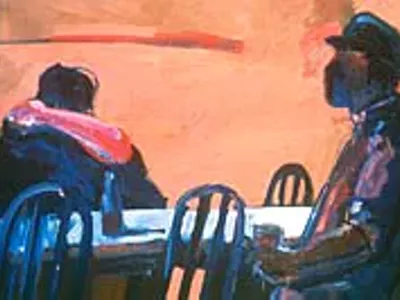He was always around, though we never knew him. We’d be doing our own rounds of the city and all of a sudden we’d come upon him; his camera poised to take a picture of an abandoned bank or a nothing-special house in a rundown neighborhood. He’d be like a great blue heron stalking a bass in a marsh — kind of awkward, prehistoric and out of place — but marvelously elegant with his lean, aristocratic, prep-school presence draped with a cashmere overcoat standing by a nice car.
“That’s Duffy! The dude that supports the artists!”
Or he’d stand out all the way across the arena at a Wings game, sitting in good seats with one or two of the artists. Or he’d show up all of sudden at art openings, standing radiantly bewildered in a Palm Beach linen suit.
On the occasion of the 300th anniversary of the founding of Detroit, three of its main art institutions — the Detroit Institute of Arts, the Elaine L. Jacob Gallery of Wayne State University and the Center Galleries at the College for Creative Studies — have mounted exhibitions that celebrate Detroit’s Cass Corridor art community. At the center of two of the exhibitions is James F. Duffy Jr., a visionary collector who, since 1967, has been one of the prime movers on the Detroit art scene. Based in his company’s pipe-and-valve warehouse on West Jefferson, where he also commissioned museum- and public site-scaled works, Duffy collected a core of Detroit art that by all accounts, in its beguiling trickle-down effect, has fostered a whole generation of artists and given Detroit a significant contemporary art presence.
But behind this simple magnanimous support there was a unique vision. In 1983, Gil Silverman, another important collector and supporter of the arts, curated an exhibition at Detroit Focus Gallery: “Gil Silverman Selects” was a mix of well-known artists along with newcomers. The surprise was the inclusion of the vernacular architectural photographs of collector Duffy. To date these photos have not been included in other exhibitions, but from the catalog reproduction (and hearsay) they are remarkable conceptual works of art that reveal Duffy’s penchant for seeing the big picture as well as the details of each small one.
Each of the 77 pictures in Silverman’s selection (and it’s said that there are many more) surprises us with some small detail, like a feature on a face. There’s a classical arch or column on a modest apartment, an unaccountable mark or arabesque painted on a wall, the mystery of shadows and their effect on space and personality, a startling symbol such as a cross on a gas station. Collectively, they build a very convincing portrait of Detroit’s diverse identity.
Such is the purposefulness of the man behind the shy and retiring manner. But when it comes to looking at the artists that he supported and collected in his industrial warehouse, rather than seeing Duffy’s activity as patronage, it’s perhaps more fitting to see his whole project as a work of art itself, an enormous site-specific installation. More importantly it’s fitting to see Duffy as a demure but primary inspiration for these young artists.
Every one of the artists in “Up from the Streets” has been written about at length, so it’s unnecessary to revisit each one, but it is important to get the lay of the land. Over the years, Duffy punctuated the warehouse spaces with some 130 works of art, which were either commissions or pieces he had purchased from exhibitions or from the artists themselves.
There are the principal artists, such as Bob Sestok, Jim Chatelain, John Egner and Gordon Newton (Duffy collected so much of the latter’s work that he gave a major gift to the DIA which is the basis of a show there through Nov. 4). But there are many more works to be seen in the current exhibition that continue to contribute to the cultural infrastructure of Detroit. John Piet’s marvelous metal mobiles haven’t been seen in years. Steve Foust’s elegant “Buckboard” is not to be missed. And Gilda Snowden’s shaped-canvas painting, “Veronica” (1981), is a true gem.
Bob Sestok’s mural, “Untitled” (commissioned in 1973 and pictured below), is painted on the wall of the “pipe room” and signifies the musicality of the room’s various sizes and directions of pipe. It’s been said that the pipe room, with its high ceilings, was almost like a cathedral. Sestok also did a huge targetlike mural on the west end of the building that once again suggests concentric rings, like pipes, and celebrates the industrial contents of Duffy & Company. Since they are permanent, these two murals are the only works of art presently existing at the warehouse.
It’s amusing to note the metaphorical implication of the pipes and valves of Duffy & Company, to think of Duffy as the mastermind of a cultural infrastructure, opening and closing valves, inspiring other collectors or gallery owners — a Jackie Feigenson, a Susanne Hilberry — while nourishing a cultural industry of artists and citizens for years to come.
Check out What's Happening to find more details on the various exhibits showcasing Duffy's collection.
Glen Mannisto writes about visual art for Metro Times. E-mail him at [email protected]





